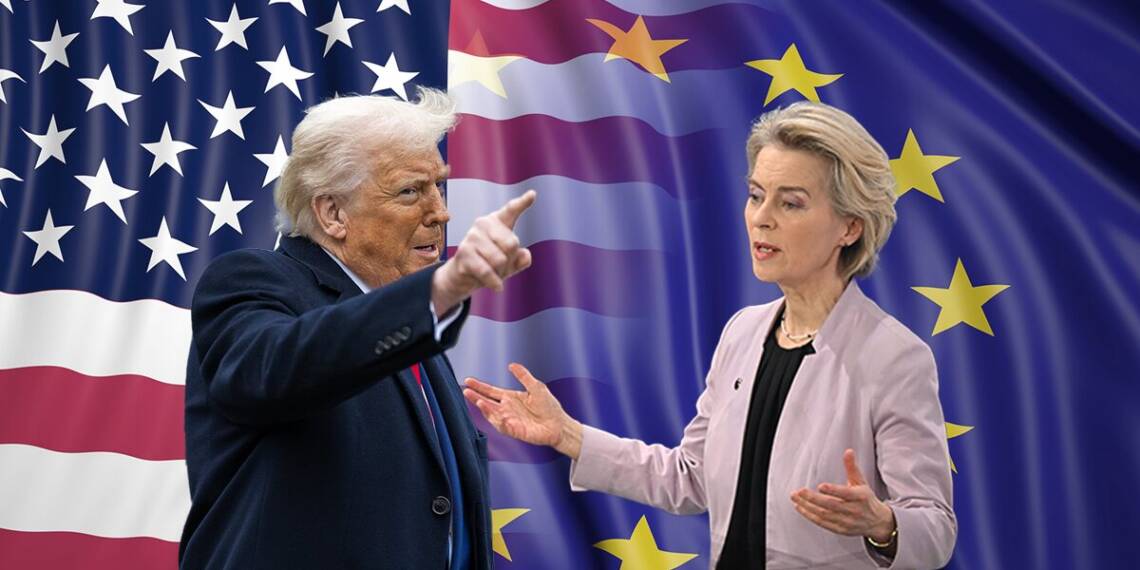The European Union has formally approved a comprehensive package of counter-tariffs worth 93 billion euros ($109 billion) on U.S. goods, set to take effect from August 7 if trade talks with the United States fail to produce a deal by the August 1 deadline, according to multiple European diplomats and official sources.
This move comes after U.S. President Donald Trump shocked the EU by threatening to impose a 30-percent tariff on European imports starting August 1 unless a trade agreement is reached. While negotiations between Brussels and Washington hint at a possible compromise involving a baseline 15-percent levy on EU goods, the EU is nonetheless proceeding with detailed retaliatory measures as a contingency, signaling a firm readiness to respond if talks collapse.
Composition of EU Counter-Tariffs
The €93 billion retaliation combines two previously proposed tariff packages:
The first, amounting to €21 billion, was approved in April 2025 but temporarily suspended to allow room for negotiations. This package targets U.S. steel and aluminum tariffs and includes agricultural products like soybeans (which face tariffs starting December 1), almonds, poultry, beef, fruit, cereals (wheat, barley, oats), vegetable oils, corn, rice, and orange juice. It also covers home appliances, sanitary products, motorcycles, motor boats, and more. Tariffs in this package range generally around 25%, with some goods like diamonds subject to a 10% duty.
The second, more extensive package adds €72 billion in tariffs targeting a broad array of goods including U.S. planes, cars, whisky, bourbon, farm animals, bees, tobacco, medical devices, machinery, chemicals, plastics, and electrical equipment. Importantly, the second package was scaled down from an initial €95 billion after public consultations removed 159 items, cutting items such as gas turbines and certain semiconductor equipment. The exact tariff level for this package has yet to be set, but up to 30% levies are on the table.
In total, the consolidated retaliation plan targets dozens of strategically and economically significant American exports, reflecting deliberate pressure points in U.S. industry and agricultural sectors. Among unexpected inclusions are niche products like condoms, opium, pearls, and hair, showcasing Brussels’ intent to strike across multiple fronts and sectors.
Political Backing and Negotiating Dynamics
The counter-tariffs package commands wide support, endorsed by 26 out of 27 EU member states, with Hungary being the sole holdout. The European Commission is spearheading the trade talks on behalf of the entire 27-nation bloc, balancing ongoing negotiations with robust fallback preparations.
Notably, influential EU capitals such as Paris and Berlin have urged a tougher stance, emphasizing the need for the EU to demonstrate resolve and readiness to retaliate decisively if necessary. This signals that beyond negotiation, Brussels is girding itself for a protracted trade standoff with Washington should diplomacy fail.
In addition to tariffs on goods, the European Commission is drafting separate retaliatory measures targeting U.S. services sectors, including technology and financial services firms, further broadening the scope of potential trade reprisals.
Potential Carve-Outs and Areas of Contention
According to diplomatic sources, the U.S. proposal under scrutiny by the EU may include sectoral exemptions or carve-outs for sensitive industries such as aircraft, lumber, pharmaceuticals, and certain agricultural products. However, no final accord has materialized yet, and tough negotiations are expected especially on tariffs affecting highly strategic sectors like aerospace and autos.
Strategic Implications
This escalation must be viewed against the backdrop of deteriorating transatlantic trade relations, with the Trump administration aggressively adopting protectionist measures while seeking to extract concessions in bilateral talks. The EU’s tough retaliatory approach is designed not only as economic pushback but as a political signal that it will not succumb to unilateral tariff impositions or what it perceives as trade blackmail.
Though there are tentative indications of movement toward a 15% baseline tariff deal reminiscent of the U.S.-Japan framework, uncertainty remains high. The looming August 1 deadline and the scheduled August 7 activation date for EU counter-tariffs sharpen the stakes.
If triggered, these tariffs could disrupt significant volumes of transatlantic trade, raise prices for consumers and businesses on both sides, and intensify already fraught political relations between major global economies. The inclusion of services in retaliation hints at a widening trade conflict beyond traditional goods tariffs.
Also Read: Trump tariff wars cutting down business deals from Europe?
The EU’s newly approved 93-billion-euro counter-tariff package crystallizes a critical moment in EU-U.S. trade relations, displaying determination to respond firmly to unilateral tariff threats while leaving room for negotiation. The coming days will be decisive in determining whether diplomacy prevails or if both sides enter a costly trade escalation.







